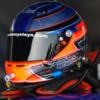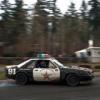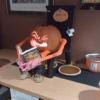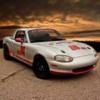I tried the P-80 emulsion and it works great. It makes it easy to install the tires and I had 1 of 4 tires slip 1/2 an inch.

Hoosier SM6 graining/break-in
#21

 Posted 03-28-2013 09:10 PM
Posted 03-28-2013 09:10 PM

#22

 Posted 03-28-2013 09:30 PM
Posted 03-28-2013 09:30 PM

My data showed the car accellerates a noticeable % slower with the Hoosiers vs. the Toyos but, of course, cornering speed is up. I thought the track was slow last weekend but we didn't have the chance to do a test to try the various setups for the tires. I somehow came in at 38 after the second race... and the last few laps were dorifto exciting. That's not where I like to have them personally.
Brian, was your data GPS based? I'm wondering if rev/mile difference might have affected your data. Although obviously the heavier tires would hurt acceleration.
CheckerLap.com -- Your race results!




#23

 Posted 03-28-2013 10:39 PM
Posted 03-28-2013 10:39 PM

Brian, was your data GPS based? I'm wondering if rev/mile difference might have affected your data. Although obviously the heavier tires would hurt acceleration.
Both were GPS based; previous was using your AIM GPS beacon and this past weekend was using my AIM Pista. Also possible for it to be ambient related?




#24

 Posted 03-28-2013 11:21 PM
Posted 03-28-2013 11:21 PM

My data showed the car accellerates a noticeable % slower with the Hoosiers vs. the Toyos but, of course, cornering speed is up. I thought the track was slow last weekend but we didn't have the chance to do a test to try the various setups for the tires. I somehow came in at 38 after the second race... and the last few laps were dorifto exciting. That's not where I like to have them personally.
Geez...come out a run away from all but 1 car and complain the track was slow ![]() Nice driving and teaching the young-ins a little race-craft!
Nice driving and teaching the young-ins a little race-craft!
Congrats on the National sweep and taking all the prizes!
Will Drago or Steyn or someone come on here and share the wealth with 1.5 years of Hoosier findings???
Ron
RAmotorsports


#25

 Posted 03-29-2013 12:07 AM
Posted 03-29-2013 12:07 AM

Both were GPS based; previous was using your AIM GPS beacon and this past weekend was using my AIM Pista. Also possible for it to be ambient related?
Ambient: you mean wind? The wind definitely makes lap times slower, all other things being equal. You need to factor that into any comparison.
CheckerLap.com -- Your race results!




#26

 Posted 03-29-2013 06:27 AM
Posted 03-29-2013 06:27 AM

Will Drago or Steyn or someone come on here and share the wealth with 1.5 years of Hoosier findings???
Ron, Brian, Juan and anyone else interested
- First off, Hoosier is the one company that only makes competition tires, so when they speak I listen. Their knowledge is invaluable.
- Chat to your fellow racers, I dont know anyone in this class that wont share tire info openly
- Hoosiers are blisteringly fast as stickers, but our expericence is that they fall off a cliff at around the 10 minute mark if driven hard as stickers. BEWARE - it will catch you out
- Make sure you are analyzing your data not just for your FRL, but also for the laps later in the race. (In Traqmate I normally open the same session 3 times and choose a lap at the beginning, midway and end of the race or session to see what is happening to the tires and how it is affecting the lap times
- Scuffing tires and putting them away for a race is done by many for certain tracks
- At some tracks many of us race on stickers and prepare for the cliff
- At other tracks, scuffs make it more predictable
- At some tracks stickers are slower, and 1-3 heat cycle tires are faster
- Hoosiers do not run the straights as well as Toyos, but in fast high compression turns like Road Atlanta Turn 1, they will give you more than 5 mph advantage over Toyos. On slower, flatter turns like Turn 7 at Road Atlanta, the gain is about +2-3mph
- Recently I have personally had some strangely different experiences with Hoosier - data that is different to my earlier data. Too early to tell what is going on. Could be shocks.
- Some drivers like coming in around 32-34psi. I like the 36-38psi range on most tracks, and several drivers like coming in over 40psi on certain tracks.
- This is what test days and practice sessions are for at each track. This takes a lot of experimentation, lots of tire pressure measurement and lots of data dissection to see what the temperature range is doing to the car on turn in, mid corner speed and exit speed, as well as rolling resistance.
- Do not forget to segment the straights in your data analysis. Rolling resistance has a surprising impact on lap times and what time you are gaining in the corners due to a "better feeling" tire, you might well be throwing away on the straights due to increased rolling resistance.
- Understand where the passing sections of the track are, and consider adjusting your tire pressure to give you an advantage there
- During test and practice sessions we always measure during the session after a 100% lap. After races we try hustle the in-lap to get pressures as close to race conditions as possible
- We have found that higher pressures help combat graining
- H20's will make you feel like god, it just amazing what speed you can carry in the turns, how late you can brake and how much water they can pump
- On the water pumping issue, understand that running behind others on Hoosiers in the rain is VERY different than running behind others on Toyos in the rain. The amount of water pumped out will ensure that you are racing blind. Just check out my VIR National race video below
- H20's are really only good in really wet conditions. If it dries out mid session, you will end the raceworthyness of those rain tires very fast. They are soft and wear out quickly on a dry track
- I have two sets of rains mounted, one worn set for test days and qualifying sessions etc. And one race set with a 1 lap scrub to remove any film.
Anyway that's all I can think of for now. Others feel free to add in your own experiences to this list or tell me how far off I am
- Juan Pineda likes this
Danny
Danny Steyn Racing | DSR YouTube Channel
Danny Steyn Photography | Adept Studios | Ocean Machinery | OPM Autosports | Rossini Racing Engines | G-Loc Brakes |
2 x SCCA Runoffs Champ | 1 x NASA National Champ | 6 x June Sprints Champ | 10 x ARRC Champ
1 x SCCA Super Sweep | 2 x Triple Crown | 4 x Hoosier Super Tour Points Champ | 6 x Majors Points Champ | 5 x SEDiv Driver of the Year











#27

 Posted 03-29-2013 02:49 PM
Posted 03-29-2013 02:49 PM

Hey Danny,
Thanks for the great report! Lots of wisdom in there. A few followups:
1) When you race on stickers and see that cliff, do you (sometimes) see graining? I'm wondering if the cliff might partially be due to graining.
2) How many sessions do you get before the tires are exhausted? Does it make a difference whether they were scuffed or raced on stickers?
3) Is the rate at which the rubber is worn off the tires affected by whether they are scuffed vs. raced with stickers?
4) How much rubber is left at the end when the tires are exhausted? If plenty, then maybe better not to rotate tires so you maintain optimal camber wear-in?
5) One of the challenges I foresee is predicting when the tire is going to be exhausted. You don't want to go out in a race or qual session only to find the tires are done. What strategy to manage that? I tried using a durometer, but the numbers didn't seem to make sense. Are there other tools? The fingernail test?
Thanks!
-Juan
CheckerLap.com -- Your race results!




#28

 Posted 03-29-2013 03:15 PM
Posted 03-29-2013 03:15 PM

With regards to the graining.. Only have 3 races under my belt on the SM6, dad has 8 or so..
The tires off the '91 miata always look bitchen, the '99 tires look like the picture with the graining and funny wear on the outside half. I know that dads '99 has less camber than my '91.
Possible you just dont have enough camber.
- Juan Pineda likes this
#29

 Posted 03-29-2013 03:42 PM
Posted 03-29-2013 03:42 PM

Hey Danny,
Thanks for the great report! Lots of wisdom in there. A few followups:
1) When you race on stickers and see that cliff, do you (sometimes) see graining? I'm wondering if the cliff might partially be due to graining.
2) How many sessions do you get before the tires are exhausted? Does it make a difference whether they were scuffed or raced on stickers?
3) Is the rate at which the rubber is worn off the tires affected by whether they are scuffed vs. raced with stickers?
4) How much rubber is left at the end when the tires are exhausted? If plenty, then maybe better not to rotate tires so you maintain optimal camber wear-in?
5) One of the challenges I foresee is predicting when the tire is going to be exhausted. You don't want to go out in a race or qual session only to find the tires are done. What strategy to manage that? I tried using a durometer, but the numbers didn't seem to make sense. Are there other tools? The fingernail test?
Thanks!
-Juan
No problem Juan, my pleasure. However my answers to your questions above are probably not what you want to hear. My motivation is how to get the fastest lap times, and if that means going out on Stickers every time, then that is something I would seriously consider at the important races. But lets see if this helps. Others may have very different experiences.
1) When you race on stickers and see that cliff, do you (sometimes) see graining? I'm wondering if the cliff might partially be due to graining.
Nothing to do with graining. Road Atlanta does not grain Hoosiers, but around lap 7 on stickers, get ready for a wild ride.
2) How many sessions do you get before the tires are exhausted? Does it make a difference whether they were scuffed or raced on stickers?
You can run Hoosiers till they cord, then they are exhausted. This could take 10 heat cycles or more. However I have only found that you can be competitive at around the 0-4 cycle range compared to someone on newer tires. If you scuff (1 or 2 laps at 80%) it appears that tires will last longer. Cannot tell how long as I normally remove tires around 3-4 heat cycles and sell the tires (Buras seems to go really fast on my takeoffs ![]() )
)
3) Is the rate at which the rubber is worn off the tires affected by whether they are scuffed vs. raced with stickers?
Cannot help you on this, sorry
4) How much rubber is left at the end when the tires are exhausted? If plenty, then maybe better not to rotate tires so you maintain optimal camber wear-in?
Never rotated my tires, new tires are faster, so no point in spending the money to get more life, yet slower times
5) One of the challenges I foresee is predicting when the tire is going to be exhausted. You don't want to go out in a race or qual session only to find the
tires are done. What strategy to manage that? I tried using a durometer, but the numbers didn't seem to make sense. Are there other tools? The fingernail
test?
Less than 4 heat cycles to win. Less than cording to test and practice
- Juan Pineda likes this
Danny
Danny Steyn Racing | DSR YouTube Channel
Danny Steyn Photography | Adept Studios | Ocean Machinery | OPM Autosports | Rossini Racing Engines | G-Loc Brakes |
2 x SCCA Runoffs Champ | 1 x NASA National Champ | 6 x June Sprints Champ | 10 x ARRC Champ
1 x SCCA Super Sweep | 2 x Triple Crown | 4 x Hoosier Super Tour Points Champ | 6 x Majors Points Champ | 5 x SEDiv Driver of the Year











#30

 Posted 03-29-2013 03:59 PM
Posted 03-29-2013 03:59 PM

Are the Hoosiers spining on the wheel under braking only, or do you feel that they spin in corners also.



#31

 Posted 03-29-2013 04:44 PM
Posted 03-29-2013 04:44 PM

Regarding tire slippage, I re-marked my tires after 5 sessions to check for continued slippage. Sure enough, they slipped more. So the problem isn't limited to the initial sessions.
On my second set of Hoosiers, the shop used aqua-net for lubricant (alcohol based instead of the water based) when mounting, but they still slipped.
Seems a tough problem.
We mount dry. We always mark. They still slip, a few inches. We re balance as you don't want vibrations either. Insist that your Hoosier guy mount dry. I think I have heard hair spray works well as it drys sticky. But I have not tried.
Pat they slip under braking, we dont have enough HP to slip them under accel.
I have run the tires as stickers and never really get the cliff that Danny experiences. We must be going at it from different ends or something? I prefer to run about 2-3 laps on stickers and then put up to race on later. I find the tires completely consistent from lap 1-lap 25 that way as long as I nail my pressures. I don't see those tires any slower than stickers, maybe one golden lap, but that is about it. Pat and Craig like racing stickers more than I do.
East Street Auto Parts
Jim@Eaststreet.com
800 700 9080













#32

 Posted 03-29-2013 06:08 PM
Posted 03-29-2013 06:08 PM

Pat, some time back Saul swore (eh, he really dosen't swear) that International Products emulsion lube p-80 worked very well with zero rotation. Per say the stuff is really slipery and after mounting drys like it was never there. He marked tires to prove to himself it good stuff. Google for it and you will find it on e-bay for $6.00 per quart plus shipping. There are also other sellers. ![]()



#33

 Posted 03-29-2013 06:10 PM
Posted 03-29-2013 06:10 PM

Jim,
Curiously last weekend at Thunderhill we found the rears slipping in the direction that would indicate acceleration. I saw as much as 5" of slippage on my tires. Another car saw 1/3 of a revolution! The fronts slipped in the opposite direction indicating braking, but much less, more like 1". I'm interested that you have not seen the rears slipping because it may confirm my theory.
Obviously the acceleration forces on the rear are much less than the braking forces, so why would the rears slip more? My thinking is that the slipping happened as we rolled 4-off over the runoff in the essex and between T14 and 15. That runoff is really really bumpy, enough to bottom out the shocks. So my theory is that this rather large tire deformation enhanced the slippage while the tire was being driven. Presumably this would also happen under braking if we somehow were braking over a very rough surface. But we don't brake under such surfaces because they don't offer much braking traction.
Thanks!
-Juan
CheckerLap.com -- Your race results!




#34

 Posted 03-30-2013 06:01 AM
Posted 03-30-2013 06:01 AM

#35

 Posted 03-30-2013 09:57 AM
Posted 03-30-2013 09:57 AM

Jim,
Curiously last weekend at Thunderhill we found the rears slipping in the direction that would indicate acceleration. I saw as much as 5" of slippage on my tires. Another car saw 1/3 of a revolution! The fronts slipped in the opposite direction indicating braking, but much less, more like 1". I'm interested that you have not seen the rears slipping because it may confirm my theory.
Obviously the acceleration forces on the rear are much less than the braking forces, so why would the rears slip more? My thinking is that the slipping happened as we rolled 4-off over the runoff in the essex and between T14 and 15. That runoff is really really bumpy, enough to bottom out the shocks. So my theory is that this rather large tire deformation enhanced the slippage while the tire was being driven. Presumably this would also happen under braking if we somehow were braking over a very rough surface. But we don't brake under such surfaces because they don't offer much braking traction.
Thanks!
-Juan
I think you may be on to something. I drove off track over gators and rough terrain and back on track without braking and experienced tire slippage. I can't swear what direction the slippage was, but no braking was involved. This was over a year ago and my first weekend on SM6's, the tires were not mounted dry. Dry mounting helps a lot, so does not driving off track.

#36

 Posted 03-30-2013 10:50 AM
Posted 03-30-2013 10:50 AM

I can't mount dry as my rusty old circa 1850 Coats machine doesn't have enough oomph so I tried the P-80 and it does make the tires go on very easily. When I worked in bike shops many years ago, we used hairspray to slide grips on the handlebars prior to learning how to float them on with compressed air and I don't think the hairspray did better at preventing rotation than dry rubber. Soapy water was horrible. One variable people haven't mentioned in the tire slipping is what rims they're using. The mating surfaces aren't going to be exactly the same dimensions, especially when you add the paint. I've only mounted mine on TD 1.1 rims so far so quite possibly the reason why I'm very happy with the way the p-80 works compared to other lubes or non isn't so much the lube, but the rim dimensions.



1 user(s) are reading this topic
0 members, 1 guests, 0 anonymous users




 Sign In
Sign In Create Account
Create Account



 Back to top
Back to top Report
Report








